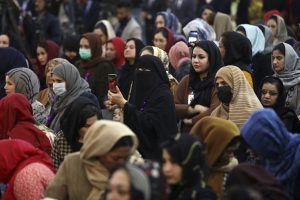[ad_1]
The Pulse | Security | South Asia
If guarantees of preserving progress in women’s rights are not included in any potential political settlement, they remain prone to reverses.

In this March 7, 2021 file photo, Afghan women attend an event to mark International Women’s Day in Kabul, Afghanistan.
Credit: AP Photo/Rahmat Gul, File
As the U.S. withdraws its troops from Afghanistan, the status of women hangs in the balance. The Taliban’s influence in post-U.S. Afghanistan will grow to the detriment of Afghan women, whether the group takes power militarily or joins the government via a peace deal. Moreover, the implications for women in rural areas where Taliban have absolute control will be even more dire compared to women working in major urban centers like Kabul.
The recent unclaimed attack on a girls’ school in Kabul, killing 84 girls, underscores the threat that the post-U.S. withdrawal poses to women in Afghanistan. Jihadist organizations across the ideological spectrum have been oppressive toward women in Afghanistan but the Taliban’s case is particularly instructive. Notwithstanding the Taliban’s lip service to the topic of women’s rights to assuage the international community’s concerns, their ideological position more or less remains the same: regressive and harsh. A combination of Pashtun tribalism and Deobandi anti-culturalism accounts for the Taliban’s patriarchal outlook. The anti-women posture in the Taliban’s ideology is a sub-set of their broader anti-Western and anti-secular worldview, in which women’s emancipation is seen as a contradiction to Islam.
If guarantees of preserving progress in women’s rights are not included in any potential political settlement, these rights remain prone to reverses. Ahead of the U.S. exit, some businesses, firms and institutions employing women in Afghanistan have started making alternatives plans, anticipating the Taliban’s return to power. Some women have quit their jobs. Other firms are relocating their offices from Afghanistan.
Women constitute approximately 48.7 percent of Afghanistan’s population. More importantly, two-thirds of Afghanistan’s population is under the age of 25. Many have never lived under the Taliban’s harsh rule. Many Afghans grew up in an environment where women were allowed to access education and pursue careers of their choosing. For this young Afghan population, the possible return of the Taliban to power would be deeply troubling.
Traditionally, in the Indian subcontinent, the Deobandi movement, of which the Taliban are a militant variant, has been countercultural in its manifestation. As a puritanical movement, the Deobandi movement opposed the syncretic tradition of South Asian Sufi Islam, believing a literalist following of Islam is pivotal in reviving Islam’s lost glory. The 1980s Afghan Jihad, and the militarization of Deobandism, further entrenched countercultural tendencies as witnessed during the Taliban’s regime in Afghanistan. The Taliban’s emphasis on a Shariah-based governing system is a continuation of their quest to cleanse Islam of so-called impurities and innovations, and the progress achieved in women’s rights will arguably be the first major casualty. Recent U.S. intelligence estimates note that the Taliban’s restrictive approach toward women has broadly remained consistent.
Of course, the repression of women in Afghanistan predates the Taliban’s theocratic rule. Reforms aimed at modernizing the social apparatus often triggered considerable blowback. Arguably, the Taliban’s rise to power only worsened the already abysmal state of affairs for women in Afghan society. Tribal law has historically constrained women’s rights in the country. Overall, patriarchy provides the foundation for all gender and social relations; it is deeply embedded in Afghanistan’s local communities and ways of life. A weak central government and its inability to bring reforms within the structure of government only serves to strengthen tribal feudalism and further marginalize women.
Over time, it has become evident that in the Taliban’s patriarchal understanding of both culture and religion, the positioning of women is a central marker of identity, and that is precisely the reason for their lopsided focus on controlling women’s mobility and sexuality. This forms the centerpiece of their governance approach, using varied forms of cultural and patriarchal frameworks for justifying the atrocities committed against women, as it keeps the power structure intact. Ensuring the sexual hierarchy and gender status quo by using political violence safeguards the Taliban’s influence.
Women’s rights and liberties should not be traded for a political settlement and power-sharing agreement with the Taliban. Research indicates that gender-inclusive peace settlements are long-lasting and more durable than settlements that exclude women. Hence, a gender-inclusive peace settlement is needed that ensures women’s rights and upholds the constitutional guarantee of their participation in politics.
Preserving women’s rights in post-U.S. Afghanistan is not just a moral imperative but a demographic demand. The Taliban’s vague claims that their position on women’s rights has moderated over time should be taken with a heavy dose of skepticism. Forty years of war and conflict have only brought suffering and misery to women and other marginalized groups in Afghanistan. For a durable peace, acknowledging the suffering of marginalized groups and making them a stakeholder in the settlement and the future power structure is imperative.
[ad_2]
Source link